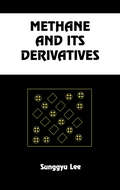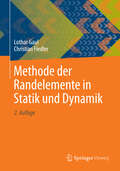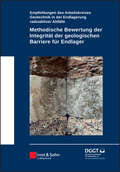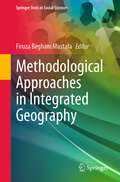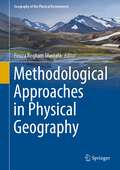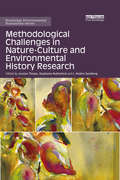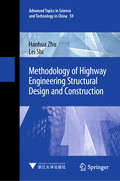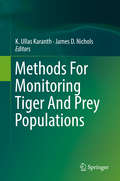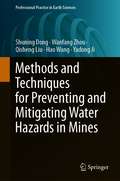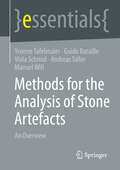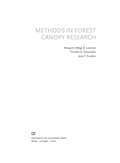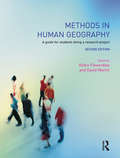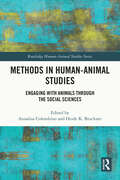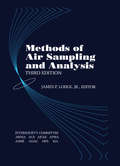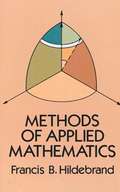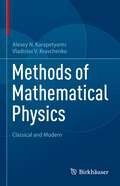- Table View
- List View
Methane and its Derivatives (Chemical Industries Ser. #70)
by Sunggyu Lee"Covers the chemistry, process chemistry, technology, engineering, and economics of methane conversion, including its environmental impact and commercial exploitation. Begins with methane's availability and increasing importance as an environmentally acceptable natural resource alternative and feedstock."
Methode der Randelemente in Statik und Dynamik
by Lothar Gaul Christian FiedlerDie gut eingeführte Methode der Randelemente baut auf den Grundlagen der Kontinuumsmechnik auf. In diesem Buch wird sie für die Elastodynamik schwingender Strukturen und für die Elastostatik formuliert. Die mathematischen und ingenieurwissenschaftlichen Grundlagen werden bereitgestellt; einfache Beispiele erleichtern das Verständnis. Das Buch liegt nun in einer 2. korrigierten Auflage vor. Es richtet sich an Studierende, Ingenieure und Naturwissenschaftler, die sich Kenntnisse der Randelementmethode erarbeiten wollen.
Methoden zur Analyse von Steinartefakten: Eine Übersicht (essentials)
by Yvonne Tafelmaier Guido Bataille Viola Schmid Andreas Taller Manuel WillDieses essential gibt einen Überblick über aktuelle Analysemethoden von Gesteinsartefakten von der Attributanalyse ganzer Inventare bis hin zu mikroskopischen Gebrauchsspurenanalysen einzelner Artefakte. Dabei zeigen die vorgestellten Ansätze die Bandbreite der Analyse urgeschichtlicher Steinartefakte im deutschsprachigen Raum. Einfache Anwendungsbeispiele veranschaulichen die Möglichkeiten und Einschränkungen der jeweiligen Methode. Der Inhalt und die Struktur des essentials ist identisch mit Unterrichtseinheiten zur Erlernung von Methoden der Steinartefaktanalyse an der Universität Tübingen im Fachbereich Ältere Urgeschichte.
Methodische Bewertung der Integrität der geologischen Barriere für Endlager
by Deutsche Gesellschaft für GeotechnikMethodological Approaches in Integrated Geography (Springer Texts in Social Sciences)
by Firuza Begham MustafaThis book covers methodology of the study for all aspects of human geography. As a comprehensive geography textbook, it consists of detailed research methodology for research in human geography including a few selected case studies in Asia. It explores different approaches, methodological possibilities, and challenges in conducting geographical research in human geography. New digital geographic data sources and GIS applications can help researchers to receive clearer concepts and obtain better measurements of the relevant attributes changes. Furthermore, the book provides an opportunity to critically examine the conceptualization and identification of the field in geographical research and how digital media has not only expanded the scope of what constitutes the field but has redefined the field in itself as well as the practices of observing, knowing, and analyzing the real world. The uniqueness of this book is due to the contribution of several professors and subject experts from South East and East Asia with special particular reference to cases studies from this region of the world.
Methodological Approaches in Physical Geography (Geography of the Physical Environment)
by Firuza Begham MustafaGeography science aims to observe the dynamics in describing earth's surface as a place and space for humans to carry out their lives, starting from simple identification using recording and sketching models, then utilizing tools such as maps, satellite imagery, statistics and Geographic Information Systems (GIS). In the development of geography science, it is appropriate to explain phenomena of the earth in the present context along with the process of developing science and technology using suitable and effective methods. Physical geography is the branch of natural science that deals with the study of processes and patterns in the natural environment such as the atmosphere, hydrosphere, lithosphere and biosphere. This book covers the methodology of the study for all aspects of physical geography, biosphere, hydrosphere, lithosphere, and atmosphere. A comprehensive geography textbook consists of a detailed research methodology for physical geography research including a few selected case studies in Asia. The uniqueness of this book is due to the contribution of several professors and subject experts from South East and East Asia with special particular reference to cases studies from a particular region. This book covered selected methodological approaches for hydrology, climatology and geomorphology including the discovery of the best method for exploring and assessing mysterious physical phenomena using a diversity of methodologies. This book explains the principal concept, basic method, optional method, detailed description of each method, and the advantages and disadvantages of the various methods. The technique of data selection, data acquisition, method of analysis, data interpretation and data analysis techniques with a specific focus on deterministic modeling, geography techniques, geospatial modeling with Geographic Information System (GIS), Artificial Intelligence (AI), Analytic Hierarchy Process (AHP), and Automated machine techniques and combination of statistical analysis. This book attempts to explore different approaches, methodological possibilities and challenges in conducting geographical research in physical geography. New digital geographic data sources and GIS applications can help researchers to receive clearer concepts and obtain better measurements of the relevant attributes changes in the physical environment. Opportunity to critically examine the conceptualization and identification of the field in geographical research and how digital media has not only expanded the scope of what constitutes the field but has redefined the field in itself as well as the practices of observing, knowing, and analyzing the real world.
Methodological Challenges in Nature-Culture and Environmental History Research (Routledge Environmental Humanities)
by L. Anders Sandberg Jocelyn Thorpe Stephanie RutherfordThis book examines the challenges and possibilities of conducting cultural environmental history research today. Disciplinary commitments certainly influence the questions scholars ask and the ways they seek out answers, but some methodological challenges go beyond the boundaries of any one discipline. The book examines: how to account for the fact that humans are not the only actors in history yet dominate archival records; how to attend to the non-visual senses when traditional sources offer only a two-dimensional, non-sensory version of the past; how to decolonize research in and beyond the archives; and how effectively to use sources and means of communication made available in the digital age. This book will be a valuable resource for those interested in environmental history and politics, sustainable development and historical geography.
Methodologies for Estimating the Economic Impacts of Natural Disasters (Integrated Disaster Risk Management)
by Hirokazu Tatano Yoshio KajitaniThis book outlines methodologies to estimate the economic impacts of natural disasters based on business surveys conducted after large disasters in Japan. By including numerous observations on business activities in past disasters and the validations of both engineering and economic models based on these data sets, this book appeals to practitioners who estimate the regional economic impacts as well as to students and young professionals in various fields who conduct disaster impact studies. The book consists of 7 chapters and includes theories and practices, which help readers to interlink the estimation methods with real-world problems. The study primarily focuses on cases in Japan, but the methods employed can be generalized and applied in other countries.
Methodology of Highway Engineering Structural Design and Construction (Advanced Topics in Science and Technology in China #59)
by Hanhua Zhu Lei ShiThis book mainly studies the methodologies of structural design and construction for highway engineering, which are applicable to the overall control and the precise operation of engineering structures. It explores the method of comprehensive analysis, the simplification of complex problems, and the application of typical engineering tools. In turn, the book presents a number of innovative approaches, e.g. the coordinated control of structural deformation method, the theory of underground engineering balance and stability, and the soft soil foundation treatment of “bumping at the bridgehead.” These methodologies are then illustrated in typical cases and representative problems, explained from a practical standpoint. Examples in special settings are also discussed, e.g. highway construction in Tibet, and rebuilding after the Wenchuan earthquake. The book offers a valuable reference guide for all those whose work involves highway engineering design, construction, management, and scientific research.
Methods For Monitoring Tiger And Prey Populations
by K. Ullas Karanth James D. NicholsThis book addresses issues of monitoring populations of tigers, ungulate prey species and habitat occupancy, with relevance to similar assessments of large mammal species and general biodiversity. It covers issues of rigorous sampling, modeling, estimation and adaptive management of animal populations using cutting-edge tools, such as camera-traps, genetic identification and Geographic Information Systems (GIS), applied under the modern statistical approach of Bayesian and likelihood-based inference. Of special focus here are animal survey data derived for use under spatial capture-recapture, occupancy, distance sampling, mixture-modeling and connectivity analysees. Because tigers are an icons of global conservation, in last five decades,enormous amounts of commitment and resources have been invested by tiger range countries and the conservation community for saving wild tigers. However, status of the big cat remains precarious. Rigorous monitoring of surviving wild tiger populations continues to be essential for both understanding and recovering wild tigers. However, many tiger monitoring programs lack the necessary rigor to generate the reliable results. While the deployment of technologies, analyses, computing power and human-resource investments in tiger monitoring have greatly progressed in the last couple of decades, a full comprehension of their correct deployment has not kept pace in practice. In this volume, Dr. Ullas Karanth and Dr. James Nichols, world leaders in tiger biology and quantitative ecology, respectively, address this key challenge. The have collaborated with an extraordinary array of 30 scientists with expertise in a range of necessary disciplines - biology and ecology of tigers, prey and habitats; advanced statistical theory and practice; computation and programming; practical field-sampling methods that employ technologies as varied as camera traps, genetic analyses and geographic information systems. The book is a 'tour de force' of cutting-edge methodologies for assessing not just tigers but also other predators and their prey. The 14 chapters here are lucidly presented in a coherent sequence to provide tiger-specific answers to fundamental questions in animal population assessment: why monitor, what to monitor and how to monitor. While highlighting robust methods, the authors also clearly point out those that are in use, but unreliable. The managerial dimension of tiger conservation described here, the task of matching monitoring objectives with skills and resources to integrate tiger conservation under an adaptive framework, also renders this volume useful to wildlife scientists as well as conservationists.
Methods and Techniques for Preventing and Mitigating Water Hazards in Mines (Professional Practice in Earth Sciences)
by Hao Wang Shuning Dong Wanfang Zhou Qisheng Liu Yadong JiThis book summarizes the advances in mine hydrogeology in terms of the development of new technologies and sustainable mining to prevent water inrush disasters during coal-mine construction and production in China. It presents holistic topics that balance safe coal mining and the minimization of impacts on the environment and human beings. Systematically describing the methods and techniques used in China’s coal mines to predict, prevent and mitigate water inrushes, it includes nine case studies to illustrate the practical engineering solutions using state-of-art methods and technologies under various conditions. It also discusses how the approaches could help solve the world’s water problems, not only in mining, but also in tunneling, disposing of nuclear waste, storing natural gas, and sequestering CO2, as well as their impact on mining industries and related fields around the world. The book intended for students, researchers and practitioners working in the mining industries.
Methods and Technologies for Measuring the Earth’s Gravity Field Parameters (Earth Systems Data and Models #5)
by V. G. Peshekhonov O. A. StepanovThis book offers extensive information on the operation of gravimeters, including airborne, marine and terrestrial ones, and on the associated data processing methods such as optimal and adaptive filtering, smoothing, structural and parametric identification. Further, it describes specific features relating to the study of the gravitational field in remote areas of the Earth, with the necessary modifications of equipment and software for all-latitude applications. Findings from gravity studies in such remote areas are also presented. Advanced methods for studying the gravitational field, including those for simultaneous determination of gravity anomalies and deflection of the vertical are described and analyzed in detail. Gravity gradiometers and cold atom gravimeters are also covered. Last but not least, the book deals with the development of Earth’s gravity field models and their various applications, including map-aided navigation, with a special attention to model accuracy estimation. Gathering research findings and best practice recommendations relating to Earth’s gravity field measurements, collected by a team of researchers and professionals, the book offers a unique guide for engineers, scientists and graduate students dealing with terrestrial, marine and airborne gravimetry. It will also help other specialists involved in developing and using navigation systems in practice, including designers of gravimetric equipment and navigators.
Methods for Bioremediation of Water and Wastewater Pollution (Environmental Chemistry for a Sustainable World #51)
by Eric Lichtfouse Inamuddin Abdullah M. Asiri Mohd Imran AhamedThis book presents advanced techniques for wastewater treatment and the chapters review the environmental impact of water pollution, the analysis of water quality, and technologies for the preservation of water resources. Also outlined in this volume is the bioremediation of heavy metals, dyes, bisphenols, phthalates, cyanobacteria in contaminated water and wastewater. Another focus of this book is the use of natural remediation techniques such as bacterial biofilms and enzymes.
Methods for Multilevel Analysis and Visualisation of Geographical Networks
by Céline Rozenblat Guy MelanconThis leading-edge study focuses on the latest techniques in analysing and representing the complex, multi-layered data now available to geographers studying urban zones and their populations. The volume tracks the successful results of the SPANGEO Project, which was set up in 2005 to standardize, and share, the syncretic, multinational mapping techniques already developed by geographers and computer scientists. SPANGEO sought new and responsive ways of visualising urban geographical and social data that reflected the fine-grained detail of the inputs. It allowed for visual representation of the large and complex networks and flows which are such an integral feature of the dynamism of urban geography. SPANGEO developed through the 'visual analytics loop' in which geographers collaborated with computer scientists by feeding data into the design of visualisations that in turn spawned the urge to incorporate more varied data into the visualisation. This volume covers all the relevant aspects, from conceptual principles to the tools of network analysis and the actual results flowing from their deployment. Detailed case studies set out in this volume include spatial multi-level analyses of flows in airports and sea ports, as well as the fascinating scientific networks in European cities. The volume shows how the primary concern of geography--the interaction of society with physical space--has been revivified by the complexities of new cartographical and statistical methodologies, which allow for highly detailed mapping and far more powerful computer analysis of spatial relationships.
Methods for the Analysis of Stone Artefacts: An Overview (essentials)
by Yvonne Tafelmaier Guido Bataille Viola Schmid Andreas Taller Manuel WillThis essential gives an overview of current methods of analysis of stone artefacts ranging from attribute analysis of entire inventories to microscopic analyses of traces of use of individual artefacts. The presented approaches show the range of analysis of prehistoric stone artefacts in the German-speaking area. Simple examples of application illustrate the possibilities and limitations of each method. The content and structure of the essentials is identical to teaching units for learning methods of stone artefact analysis at the University of Tübingen in the Department of Early Prehistory.
Methods in Forest Canopy Research
by Margaret D. Lowman Timothy D. Schowalter Jerry F. FranklinPoised between soil and sky, forest canopies represent a critical point of exchange between the atmosphere and the earth, yet until recently, they remained a largely unexplored frontier. For a long time, problems with access and the lack of tools and methods suitable for monitoring these complex bioscapes made canopy analysis extremely difficult. Fortunately, canopy research has advanced dramatically in recent decades. Methods in Forest Canopy Research is a comprehensive overview of these developments for explorers of this astonishing environment. The authors describe methods for reaching the canopy and the best ways to measure how the canopy, atmosphere, and forest floor interact. They address how to replicate experiments in challenging environments and lay the groundwork for creating standardized measurements in the canopy--essential tools for for understanding our changing world.
Methods in Human Geography: A guide for students doing a research project
by Robin Flowerdew David M. MartinFirst published in 2004. Routledge is an imprint of Taylor & Francis, an informa company.
Methods in Human-Animal Studies: Engaging With Animals Through the Social Sciences (Routledge Human-Animal Studies Series)
by Annalisa Colombino Heide K. BrucknerThis timely book provides a methodological guide for how to conduct and theorise research in human-animal studies. In response to critiques of the anthropomorphic slant to human-animal research and the increasing political relevance of animals in contemporary environmental debates, this book emphasises methods which bring to light the animal side of multispecies encounters. Drawing from the interdisciplinary strength of human-animal studies, this book contains contributions from practitioners and scholars working in sociology, anthropology, ethology and geography. Each chapter uses a case-study approach to present a theoretical framework and empirical application of cutting-edge methods in human-animal studies, from creative writing in multispecies ethnographies to visual methods like videography and body mapping. Organized in three parts – theorizing; collaborating; visualizing – the book equips readers with methodological tools to conduct human-animal studies research attentive to animal lives. Furthermore, chapters reflect on the opportunities, limitations and ethical considerations of research that seeks to understand our more-than-human worlds. The book is aimed towards undergraduate and graduate students in human-animal studies and scholars investigating human-animal relations. It will also be of interest to practitioners and policy-makers who engage with conservation, wildlife management or the human-animal interface of urban and regional planning.
Methods in Paleoecology: Reconstructing Cenozoic Terrestrial Environments and Ecological Communities (Vertebrate Paleobiology and Paleoanthropology)
by Darin A. Croft Denise F. Su Scott W. SimpsonThis volume focuses on the reconstruction of past ecosystems and provides a comprehensive review of current techniques and their application in exemplar studies. The 18 chapters address a wide variety of topics that span vertebrate paleobiology and paleoecology (body mass, postcranial functional morphology, evolutionary dental morphology, microwear and mesowear, ecomorphology, mammal community structure analysis), contextual paleoenvironmental studies (paleosols and sedimentology, ichnofossils, pollen, phytoliths, plant macrofossils), and special techniques (bone microstructure, biomineral isotopes, inorganic isotopes, 3-D morphometrics, and ecometric modeling). A final chapter discusses how to integrate results of these studies with taphonomic data in order to more accurately characterize an ancient ecosystem. Current investigators, advanced undergraduates, and graduate students interested in the field of paleoecology will find this book immensely useful. The length and structure of the volume also makes it suitable for teaching a college-level course on reconstructing Cenozoic ecosystems.
Methods in Statistical Mechanics: A Modern View (Lecture Notes in Physics #974)
by Osvaldo Civitarese Manuel GadellaThis book presents a variety of techniques for tackling phenomena that are not amenable to the conventional approach based on the concept of probabilities. The methods described rely on the use of path integration, thermal Green functions, time-temperature propagators, Liouville operators, second quantization, and field correlators at finite density and temperature. Also exploring the statistical mechanics of unstable quantum systems, the book is intended as a supplementary or reference text for use in one-semester graduate courses on Quantum Mechanics, Thermodynamics, Electromagnetism, and Mathematical Methods in Physics.
Methods of Air Sampling and Analysis
by Jr., James LodgeIncludes precise directions for a long list of contaminants! All contaminants you can analyze or monitor with a given method are consolidated together to facilitate use. This book is especially valuable for indoor and outdoor air pollution control, industrial hygiene, occupational health, analytical chemists, engineers, health physicists, biologists, toxicologists, and instrument users.
Methods of Applied Mathematics (Dover Books on Mathematics)
by Francis B. HildebrandThis invaluable book offers engineers and physicists working knowledge of a number of mathematical facts and techniques not commonly treated in courses in advanced calculus, but nevertheless extremely useful when applied to typical problems in many different fields. It deals principally with linear algebraic equations, quadratic and Hermitian forms, operations with vectors and matrices, the calculus of variations, and the formulations and theory of linear integral equations. Annotated problems and exercises accompany each chapter.
Methods of Mathematical Physics
by Harold Jeffreys Bertha SwirlesThis well-known text and reference contains an account of those mathematical methods that have applications in at least two branches of physics. The authors give examples of the practical use of the methods taken from a wide range of physics, including dynamics, hydrodynamics, elasticity, electromagnetism, heat conduction, wave motion and quantum theory. They pay particular attention to the conditions under which theorems hold. Helpful exercises accompany each chapter.
Methods of Mathematical Physics: Classical and Modern
by Vladislav V. Kravchenko Alexey N. KarapetyantsThis textbook provides a thorough overview of mathematical physics, highlighting classical topics as well as recent developments. Readers will be introduced to a variety of methods that reflect current trends in research, including the Bergman kernel approach for solving boundary value and spectral problems for PDEs with variable coefficients. With its careful treatment of the fundamentals as well as coverage of topics not often encountered in textbooks, this will be an ideal text for both introductory and more specialized courses.The first five chapters present standard material, including the classification of PDEs, an introduction to boundary value and initial value problems, and an introduction to the Fourier method of separation of variables. More advanced material and specialized treatments follow, including practical methods for solving direct and inverse Sturm-Liouville problems; the theory of parabolic equations, harmonic functions, potential theory, integral equations and the method of non-orthogonal series.Methods of Mathematical Physics is ideal for undergraduate students and can serve as a textbook for a regular course in equations of mathematical physics as well as for more advanced courses on selected topics.
Methods to Study Litter Decomposition: A Practical Guide
by Felix Bärlocher Mark O. Gessner Manuel A. S. GraçaThe primary objective of this book is to provide students and laboratory instructors at universities and professional ecologists with a broad range of established methods to study plant litter decomposition. Detailed protocols for direct use in the field or laboratory are presented in an easy to follow step-by-step format. A short introduction to each protocol reviews the ecological significance and principles of the technique and points to key references.
